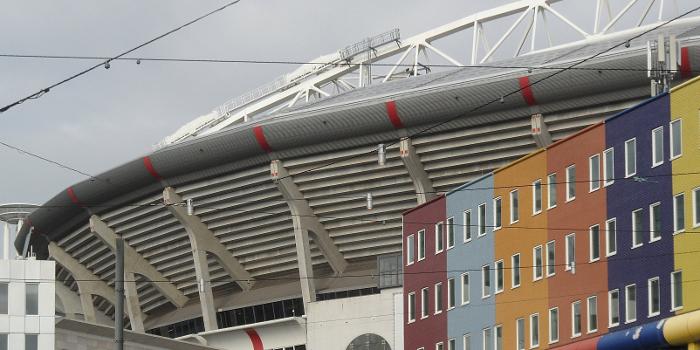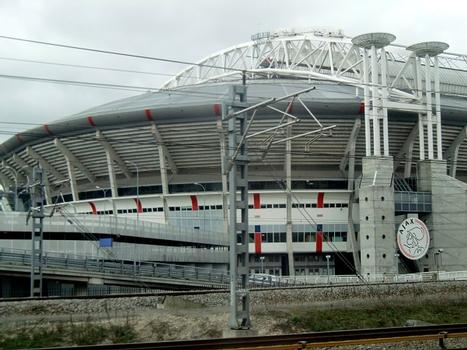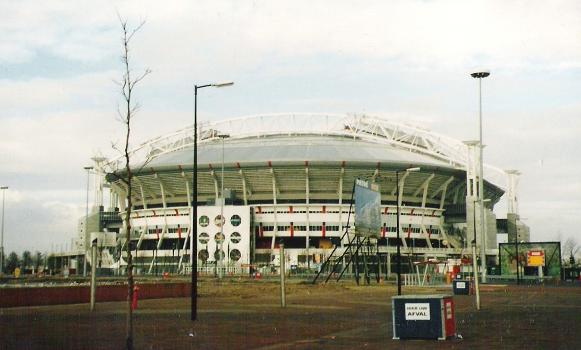General Information
| Other name(s): | Amsterdam ArenA |
|---|---|
| Beginning of works: | 26 November 1993 |
| Completion: | 14 August 1996 |
| Status: | in use |
Project Type
| Structure: |
roof: Truss |
|---|---|
| Function / usage: |
Stadium / Arena |
| Material: |
roof: Steel structure building: Concrete structure |
| Equipment: |
Structurae Plus/Pro - Subscribe Now! |
Location
| Location: |
Amsterdam, North Holland, Netherlands |
|---|---|
| Address: | Arena Boulevard 29 |
| Part of: | |
| Coordinates: | 52° 18' 52" N 4° 56' 31" E |
Technical Information
Dimensions
| seats | 55 500 | |
| playing field | width | 68 m |
| length | 105 m |
Materials
| roof truss |
steel
|
|---|---|
| grand stands |
reinforced concrete
|
Excerpt from Wikipedia
The Johan Cruyff Arena (Dutch:Johan Cruijff Arena [ˈjoːɦɑn ˈkrœyf aːˌreːnaː]; officially stylised as Johan Cruijff ArenA) is the main stadium of the Dutch capital city of Amsterdam and the home stadium of football club AFC Ajax since its opening. Built from 1993 to 1996 at a cost equivalent to €140 million, it is the largest stadium in the country. The stadium was previously known as the Amsterdam Arena (stylised as Amsterdam ArenA) until the 2018–19 football season, when it was officially renamed in honour of legendary Dutch footballer Johan Cruyff who died in March 2016.
It was one of the stadiums used during UEFA Euro 2000, and also held the 1998 UEFA Champions League Final and 2013 UEFA Europa League Final. The stadium will also host three group stage matches and one match in the round of 16 of the UEFA Euro 2020, that is postponed to the summer of 2021.
Both international and Dutch artists have given concerts in the stadium, including Tina Turner, Coldplay, Take That, Celine Dion, Madonna, Michael Jackson, André Hazes, David Bowie, AC/DC, One Direction, The Rolling Stones, Beyoncé and Rihanna. The dance event Sensation was held in the stadium every year, up until the final edition in 2017.
The stadium has a retractable roof combined with a grass surface. It has a capacity of 55,500 people during football matches, and of 68,000 people during concerts if a centre-stage setup is used (the stage in the middle of the pitch); for end-stage concerts, the capacity is 50,000, and for concerts for which the stage is located in the east side of the stadium, the capacity is 35,000. It held UEFA five-star stadium status, which was superseded by a new system of classification.
History
Amsterdam was one of six cities that bid to host the 1992 Summer Olympics. In 1986, a new Olympic stadium was designed, with a football field and an athletics track. It was to be built in the area of Strandvliet in Amsterdam Zuidoost. After Amsterdam lost the bid to Barcelona in October 1986, the plans for the new stadium were abandoned. In 1987, the Stichting Amsterdam Sportstad (English: "Amsterdam Sports City Foundation") was established, which made new plans for a sports stadium with an all-seated capacity of 55,000. In 1990, a new design was made based on both previous designs, with a football field, an athletics track, and completely covered by a roof. By this time, AFC Ajax needed a new stadium, as their previous home ground, De Meer, was far too small for most of Ajax's games. For several years, Ajax had moved its more important games to Olympisch Stadion; in practice, they played all of their European fixtures and big midweek night games at Olympisch Stadion.
Once more, the design was altered – the athletics track was removed, the capacity was reduced to 50,000 seats, and the fixed roof was replaced by a retractable roof. In 1992, the Government of Amsterdam authorised the plans for the stadium with a Transferium where people could transfer from their car to various forms of public transportation. In 1993, the Government of Amsterdam changed the development plan of the location and gave a permit to build the stadium.
The first pile of the deep foundation of the stadium was placed on 26 November 1993. The construction work, undertaken by Ballast Nedam and Royal BAM Group, took almost three years. The highest point of the building was reached on 24 February 1995, after the roof construction was raised. The fly-over from the public road to the parking facilities was opened on 13 March 1996. The stadium received 180,000 visitors during the construction work, until the stadium was closed from 1 July 1996 until the opening ceremony. The stadium was officially opened on 14 August 1996 by Queen Beatrix.
Queen Beatrix opened the stadium by making a curtain fall inside the stadium. This revealed the world's largest painting De Zee (English: The Sea) of 80 by 126 metres (262 ft × 413 ft). Two-dimensional ships were placed on the sea representing the clubs in the Eredivisie.Trijntje Oosterhuis sang the hymn "De Zee", composed for the opening ceremony by John Ewbank. An eight-day torch relay with 375 runners over 1400 kilometres through the Netherlands reached the stadium. The first runner was Johan Cruyff starting in the old stadium De Meer, and the last runner was Frank Rijkaard arriving in the new stadium. After the grass was revealed and the roof opened, an inaugural football match was played between AFC Ajax and Milan. Tina Turner opened the stadium with three concerts with 160,000 people, from her world breaking Wildest Dreams Tour.
The construction of the stadium cost an equivalent of €140 million (at the time the currency of the Netherlands was the Dutch guilder).
The stadium combines a retractable roof with a grass surface. This caused some problems in the beginning: the grass rolls would not grow in the shade of the open roof and had to be replaced up to four times a year.
Exterior renovation
In September 2015, plans were presented to renovate the stadium's facade. The renovation should provide better quality and service to visitors by widening the walkway rings around the stadium, creating more room for the visitors and for new facilities (the number of seats remains the same). As a result, the outside of the stadium transforms from a concave shape to a convex shape, drastically altering its appearance. The renovation is planned to be completed in 2020, when 4 matches of the UEFA Euro 2020 championship will be played in the Arena.
Construction works started in June 2017. The first phase is to renovate the east side of the stadium, where construction of the new facade was completed in April 2018.
Name change
On 25 April 2017, it was announced that the Amsterdam Arena would be renamed to "Johan Cruijff Arena" in memory of Ajax legend Johan Cruyff. Later that year, on 9 August, it was stated that the name change would take place on 25 October 2017. However, this was postponed as that date proved to be infeasible due to the many matters that needed to be settled, such as arranging compensation for possible loss of income, transferring part of the shares from the municipality of Amsterdam to Ajax and having a discussion with the Cruyff family.
On 5 April 2018, it was announced that the stadium would officially change name at the start of the 2018–19 football season. The stadium's new logo was revealed on 25 April 2018, the birthday of Johan Cruyff. According to the spokeswoman of Cruyff's family, the original Dutch spelling of his name (Cruijff) was chosen for the stadium's official name "to stay close to the Dutch Johan". The 2018–19 football season started in August 2018.
Building and facilities
The stadium's original architect is Rob Schuurman (from the Netherlands). Its all-seated capacity is 54,990. Before the end of the 2019-20 season, capacity will be expanded to around 56,000 seats. During music concerts, the stadium has a maximum capacity of 68,000 visitors. The parking capacity of the Transferium is 500 cars (inside); there are an additional 12,000 spots outside.
The Johan Cruyff Arena is one of two stadiums in the Netherlands that is rated as Category 4 by UEFA, the other being the Feijenoord Stadion in Rotterdam.
The Ajax Museum is located in the stadium, which shows Ajax's more than 120 years of history.
The nearest train and metro station is Amsterdam Bijlmer Arena. The metro lines 50 and 54 (Amsterdam Central Station and city center) stop here.
Text imported from Wikipedia article "Johan Cruyff Arena" and modified on 12 June 2021 according to the CC-BY-SA 3.0 license.
Participants
- Rob Schuurman (architect)
- Sjoerd Soeters (architect)
Relevant Web Sites
Relevant Publications
- (2000): The Amsterdam Arena: a multi-functional stadium. In: Proceedings of the Institution of Civil Engineers - Structures and Buildings, v. 140, n. 4 (November 2000), pp. 323-331.
- About this
data sheet - Structure-ID
20063057 - Published on:
10/04/2012 - Last updated on:
06/01/2022


.jpg)

_(2).jpg)
_-_Amsterdam_-_20409442_-_RCE.jpg)




